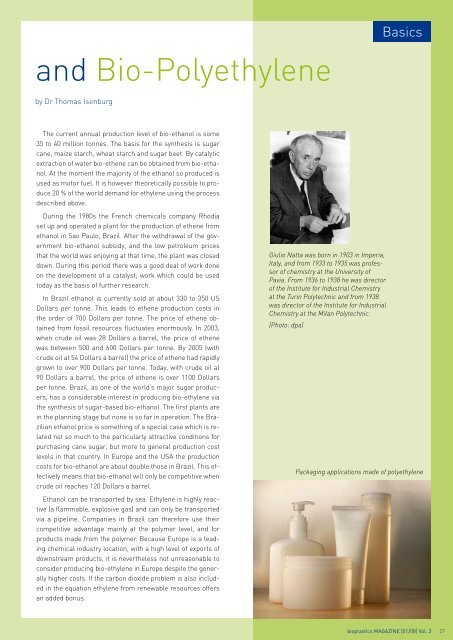01 | 2008
You also want an ePaper? Increase the reach of your titles
YUMPU automatically turns print PDFs into web optimized ePapers that Google loves.
Basics<br />
and Bio-Polyethylene<br />
by Dr Thomas Isenburg<br />
The current annual production level of bio-ethanol is some<br />
35 to 40 million tonnes. The basis for the synthesis is sugar<br />
cane, maize starch, wheat starch and sugar beet. By catalytic<br />
extraction of water bio-ethene can be obtained from bio-ethanol.<br />
At the moment the majority of the ethanol so produced is<br />
used as motor fuel. It is however theoretically possible to produce<br />
20 % of the world demand for ethylene using the process<br />
described above.<br />
During the 1980s the French chemicals company Rhodia<br />
set up and operated a plant for the production of ethene from<br />
ethanol in Sao Paulo, Brazil. After the withdrawal of the government<br />
bio-ethanol subsidy, and the low petroleum prices<br />
that the world was enjoying at that time, the plant was closed<br />
down. During this period there was a good deal of work done<br />
on the development of a catalyst; work which could be used<br />
today as the basis of further research.<br />
In Brazil ethanol is currently sold at about 330 to 350 US<br />
Dollars per tonne. This leads to ethene production costs in<br />
the order of 700 Dollars per tonne. The price of ethene obtained<br />
from fossil resources fluctuates enormously. In 2003,<br />
when crude oil was 28 Dollars a barrel, the price of ethene<br />
was between 500 and 600 Dollars per tonne. By 2005 (with<br />
crude oil at 54 Dollars a barrel) the price of ethene had rapidly<br />
grown to over 900 Dollars per tonne. Today, with crude oil at<br />
90 Dollars a barrel, the price of ethene is over 1100 Dollars<br />
per tonne. Brazil, as one of the world‘s major sugar producers,<br />
has a considerable interest in producing bio-ethylene via<br />
the synthesis of sugar-based bio-ethanol. The first plants are<br />
in the planning stage but none is so far in operation. The Brazilian<br />
ethanol price is something of a special case which is related<br />
not so much to the particularly attractive conditions for<br />
purchasing cane sugar, but more to general production cost<br />
levels in that country. In Europe and the USA the production<br />
costs for bio-ethanol are about double those in Brazil. This effectively<br />
means that bio-ethanol will only be competitive when<br />
crude oil reaches 120 Dollars a barrel.<br />
Ethanol can be transported by sea. Ethylene is highly reactive<br />
(a flammable, explosive gas) and can only be transported<br />
via a pipeline. Companies in Brazil can therefore use their<br />
competitive advantage mainly at the polymer level, and for<br />
products made from the polymer. Because Europe is a leading<br />
chemical industry location, with a high level of exports of<br />
downstream products, it is nevertheless not unreasonable to<br />
consider producing bio-ethylene in Europe despite the generally<br />
higher costs. If the carbon dioxide problem is also included<br />
in the equation ethylene from renewable resources offers<br />
an added bonus.<br />
Giulio Natta was born in 1903 in Imperia,<br />
Italy, and from 1933 to 1935 was professor<br />
of chemistry at the University of<br />
Pavia. From 1936 to 1938 he was director<br />
of the Institute for Industrial Chemistry<br />
at the Turin Polytechnic and from 1938<br />
was director of the Institute for Industrial<br />
Chemistry at the Milan Polytechnic.<br />
(Photo: dpa)<br />
Packaging applications made of polyethylene<br />
bioplastics MAGAZINE [<strong>01</strong>/08] Vol. 3 27


















